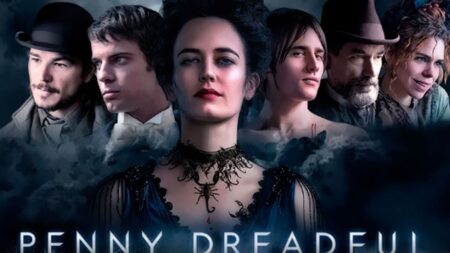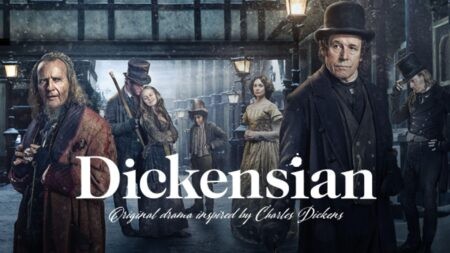I wonder how many fellow television researchers have had something published and, only when seeing it locked into the pages of a journal or a book, have realised that their thinking has already developed. Indeed, whilst television and the scholarly endeavours surrounding it are ‘to be continued…’ in perpetuity (at least, I hope so), the dominant publishing mechanisms currently at our disposal to facilitate such endeavours remain less dynamic. Thankfully, in more recent times, we have witnessed the forward momentum of sites like CST Online, to speed-up the possibilities for producing the ‘next episode’ of thought or debate. In recognition of this, I would like to share with you some further reflections I had immediately (no exaggeration) after seeing my book, Adapting Television Drama: Theory and Industry (2021), in print.
As per the blurb, my book presents and analyses original interview material from television producers, writers, directors, production designers, casting directors and actors, to uncover the creative and professional processes behind television adaptation as a material mode of production, chiefly in the context of adapting literary sources for television. Moreover, incorporating expanded notions of ‘adaptation’, my book also considers the broader ways in which the television industry as a whole is presently making necessary adaptations in the ways it tells its stories. I rely particularly on female and/or minority-ethnic industry insights to explore such ‘adaptations’ in relation to issues of equality, diversity and inclusion especially. So far, so good.
As I flicked through my complimentary copy of the book, I noticed the acknowledgment of my indebtedness to the preceding work of Sarah Cardwell, with the seminal Adaptation Revisited: Television and the Classic Novel (2002), and Shannon Wells-Lassagne, with the more recent Television and Serial Adaptation (2017), before stating my own work as the third book-length study of ‘television adaptation specifically’ (Hogg, 2021: 4). This passing, matter-of-fact statement, which I had written and thought nothing more about through the lengthy process of completing the rest of the book, suddenly took on a heightened, haunting significance when I saw it fixed on the page – forever – staring back at me. What exactly did I mean by ‘television adaptation specifically’? There are a number of existing monographs which I could credibly have added to this roll call, yet intuitively I didn’t. Why? For instance, what about Max Sexton and Malcolm Cook’s Adapting Science Fiction to Television: Small Screen, Expanded Universe (2015)? An impressively nuanced account of early television science fiction, I reasoned that I omitted this study because of its central interest in the formation of a televisual genre, as opposed to a primary focus on the status of its case-studies as adaptations, or on their adaptive processes in that sense.
The example which stuck with me the most, however, was Yvonne Griggs’ Adaptable TV: Rewiring the Text (2018), an astute exploration of contemporary television’s rich intertextuality in its storytelling, investigating innovative case-studies ranging from a neo-Victorian horror ‘mash-up’ like Penny Dreadful (Showtime, 2014-2016) to a US remake of a UK show like The Night Of (HBO, 2016). This book is even in the same series as my own with Palgrave. As Cardwell observes, critical perceptions of adaptation have ‘…been determined as much by deep-rooted feelings, attitudes and beliefs… as by… conceptualisations, theories and methodologies”, revealing responses that are ‘emotionally “felt” as much as intellectually “thought”’ (2002: 31-2). Therefore, was my omission of Griggs’ work from my roll call about a subconscious taxonomic elitism of some kind on my part? Did I see Griggs’ textual examples as adaptations ‘of sorts’ but not ‘my adaptations’? I strongly dislike such unspoken elitisms within scholarship, for reasons likely obvious to other researchers of television, so the possibility of having uncovered these sentiments in my own thinking was not an appealing one. If this was indeed a case of elitism, to make matters worse, I wasn’t even consistent in my snobbery. Although my book centres chiefly on examples of the televisual adaptation of singular literary properties, I also play around the edges with a more porous textual definition of adaptation, drawing-in more periphery examples of literary ‘mash-ups’ like Dickensian (BBC, 2015-2016) and US television remakes such as Gracepoint (Fox, 2014), much like the texts which Griggs prioritises.
In such contradictions of thought, seemingly embracing wider definitions of adaptation, yet instinctively wanting to make demarcations and exclusions, had I simply fallen foul of adaptation studies’ ‘will to taxonomize’ (Cartmell and Whelehan, 2007: 2), in a way which is incompatible with television’s ever more burgeoning textual multiplicity? I took some consolation, however, in then recognising similar contradictions in other studies that I greatly admire. For instance, Wells-Lassagne differentiates her own monograph from Cardwell’s earlier work by asserting that it is the ‘first book-length study of television adaptation as a whole’ (2017: 7), rather than of classic literary adaptations more particularly. Yet, Wells-Lassagne’s ‘whole’ intuitively draws the line at fiction, making no study of the many non-fiction format trades that take place across the expanded adaptive terrain of Albert Moran’s ‘copycat TV’ (1998). Even Griggs, in developing impressively detailed textual critiques of her chosen ‘adaptive exemplars’ (2018: 5), makes statements like, ‘[the] series is more continuation than adaptation’ (2018: 72). So, what is this broader pattern of contradictory impulses all about, to break down boundaries only to put them back up again?
Contradictions and debates of definition are certainly nothing new to adaptation studies or to television studies. What is the ‘adaptation’ of adaptation studies? What is the ‘television’ of television studies? Ring any bells? The fact is that there presently exists no consensus on what constitutes ‘television adaptation specifically’. It appears that sometimes we don’t even agree within ourselves on the matter. And, to her credit, Cardwell (2018) has already offered her own admirably lucid take on such competing instincts within the adaptation researcher, to curiously embrace plurality and connection and yet also to discern and delineate distinctiveness. Cardwell urges fellow adaptation scholars not to ‘bury or dismiss questions of what (an) adaptation is’, in our excited eagerness to explore ‘the supposedly revolutionary impact of reconceiving adaptation studies as intertextual studies’ (2018: 9), as this eagerness leaves an ‘ontological fissure’ (2018: 8) at the heart of the discipline. As Cardwell explains:
People on both sides of the creative process continue to intuit a distinction between the pleasures of intertextuality and the pleasures of adaptation – as if the two were distinguishable. Scholarly study could reconnect with pre-theoretical, intuitive perceptions, pleasures and dialogue in pursuit of clearer conceptual answers… But first we must recognise the extent of the impact of intertextuality upon adaptation studies, how it has changed not only our notion of adaptation, but also the very way in which adaptation studies is conducted… (2018: 10)
There is a mischievousness in Cardwell’s earlier remark that ‘[g]olf studies knows its focus: golf, not tennis’ (2018: 8). She immediately goes on to qualify this with an acknowledgment that adaptation studies is an inherently different proposition. Still, there is a compelling logic to Cardwell’s overall point regarding the need to revisit intuitive demarcations that we have exuberantly scrubbed out of the field. There are values to categories and boundaries, after all. They don’t just restrain things. They also help us to see more clearly what we’re working with. The television industry’s use of genre, as a primary means of bringing greater coherence and navigability to both production and consumption, is an apt example.
I am especially drawn to Cardwell’s recognition that ‘creators and consumers of adaptations outside the academy already instinctively perceive some rough-and-ready delineation’ (2018: 9). Indeed, on reflection, I believe that my own instinct to delineate, albeit ‘softly’, ‘adaptation’ (i.e., the use of a primary, identifiable preceding property from another medium to generate a television drama) from the many other forms of televisual intertextuality (such as remakes, reboots, mash-ups, reformats, prequels, sequels, continuations, expansions, spin-offs, metatexts, spoofs, and so on) stems from my closeness to the industry interview perspectives I gathered. These insights collectively prioritise seeing television adaptation as a complex – and distinctive – creative process, rather than as a textual or critical category. Repeatedly, my industry participants – from producers to writers to production designers – expressed understandings of their work on adaptation projects that were qualitatively different from the more ‘free-floating intertextuality’ (Geraghty, 2008: 43) that we might associate with other intertextual forms. Notably, notions of ‘fidelity’ – whilst largely framed pejoratively, as an unhelpful nuisance, in current academic discourse concerning adaptation texts – were deemed of continued importance for television adaptation as a creative process. ‘Fidelity’, in this context, does not refer to some obedient adherence to the details of plot, nor to some unthinking, elitist veneration – or cynical brand appropriation – of literary ‘classics’. Instead, it is about a particular creative mindset or spirit of intention within the adaptive undertaking. Producer Laura Lankester, for instance, observes of her work in shepherding television adaptation projects:
There are moments when we realise that the scripts have departed a little too far from the book and it doesn’t feel like it works for that reason. That’s when we say we should return to the book. It’s not about slavishly following content but it’s about following the spirit of the book. (Cited in Hogg, 2021: 33)
In unison, producer Belinda Campbell remarks that any creative license in television adaptation needs ultimately to be ‘tethered… to the possibilities of the book’:
…I think you do need to be able to track back the creative decisions that you make to the intentions of the source and be able to justify why you are making changes. I need to feel there’s an authenticity, a sincerity and an integrity to what we’re doing if we’re taking someone else’s characters and story, even if they’re long dead. You become a custodian of that material… (Cited in Hogg, 2021: 39)
Thus, it is evident that the creators of television adaptations enact instinctive demarcations also. In addition, producer Preethi Mavahalli talks about ‘having wrestled with the source material’ (cited in Hogg, 2021: 26) in order to decide how aspects of, for instance, gender representation from a novel written over a hundred years ago can be adapted responsibly for a contemporary television audience, whilst still maintaining the ‘spirit’ of that story. Adding further conceptual texture from the adapting screenwriter perspective, Sarah Phelps reflects on her (often controversial) changes to Agatha Christie’s plots for television, justifying them as, essentially, expressions of ‘fidelity’, to Christie as a fellow storyteller:
That’s my job as an adaptor, to pay attention not just to the beginning, middle and end, and to the mechanics of the plot, but also to the internal acoustics of what’s been written. If something doesn’t fit, maybe it’s there for a reason. Maybe it’s a glimpse of the story that Christie really wanted to write. (Cited in Hogg, 2021: 81-2)
Phelps’ reasoning is telling of the complex ways in which adapting screenwriters attempt to reconcile often strongly-felt tensions between the sort of ‘custodianship’ that Campbell mentions and their own sense of creative self-determination. Consequently, although our scholarly impulse might be to continually extend adaptation’s reach in textual terms, it is apparent that ‘adaptation’, in the context of the work of my industry interviewees at least, is a qualitatively different creative proposition, mindset and process to the more plural and playful intertextuality of various other forms of television drama.
My aforementioned contradictory impulses in attempting to define ‘television adaptation specifically’ are pertinent also to the broader contradictions of television and of television studies in more general terms. Of course, we want to recognise and to explore the full richness of television as an inherently adaptive, relational form (to computer games, to film, to theatre, to literature, to music, and so forth), and yet still we want to be able to discern the distinctiveness of television as a creative and cultural form in its own right and on its own terms. Indeed, the latter desire has been hard-fought for through the history of television studies to date, in us proving that the field is far more than just a bit of novelty ‘academic tourism’ for film theorists, literature scholars and sociologists, for instance.
Once again, Cardwell highlights an interesting possible means of tackling such tensions of thought, by suggesting that we might consider television less as a medium and more as ‘an art which employs many media’, and which does not
judge the achievements of individual television works according to their use of inter-art media per se, condemning ‘theatrical’ elements or lauding ‘cinematic ones’. Instead, we can trace within television works, via shared media, the echoes and influences of other arts. And just as we can remain open to television works that are non-televisual, so we can spot a work in another art form – a film, or a book – that is televisual… Thus it may be that, ultimately, it is in television’s ongoing enthusiastic adoption of a plethora of media that it finds its vibrancy and distinctiveness as an art. (2014: 19)
I think there is real promise along this road – but Cardwell loses me a little when she claims in the same piece that ‘[t]he question of television’s “status” need not concern us here; let us set it aside for a rainy day’ (2014: 12). I’m afraid I can’t do that, not when the history of both television production and criticism is predicated in large part upon a hierarchical sense (either intuitively or consciously felt) of relative status between arts and between their associated academic disciplines. Indeed, television’s artistic ‘inferiority complex’ is arguably what led to its enduring dependence upon the adaptation of texts from preceding, more culturally ‘elevated’ artforms, habitually looking outside of itself in aiming to bolster its own credentials. Similarly, television studies’ most prominent and/or persistent preoccupations to date can also be read as being built upon relational underpinnings with other cultural forms, either in asserting valuable difference, as in investigating distinctly televisual genres, audience practices and industry processes, for example, or in courting some sort of validation through correspondence, as was a dimension to the much-obsessed-over ‘quality television’.
A current pet peeve of mine along such lines is the notion of ‘cinematic television’, which – as very ably considered by Deborah L. Jaramillo (2013) and Brett Mills (2013) – conceals an array of pitfalls in effectively evaluating the nature and possibilities of television today. A recent example of scholarship which aims to nudge ‘cinematic television’ in a more useful direction is Rashna Wadia Richards’ Cinematic Television: Serial Drama Goes to the Movies (2021). Eschewing notions of hierarchical inheritance and imitation, Richards instead frames this relationship in more levelled-out, intertextual terms (sound familiar?). It’s a really interesting book but, ultimately, I’m still left wary of ‘cinematic television’, as a conceptual wolf in sheep’s clothing. As I mention in my own book, ‘…it seems to me that the present moment is far less about television “going to the movies” and far more about producers, creatives, distributors and audiences “switching on” to the changing possibilities of television’ (Hogg, 2021: 135).
So, where to go from here? Only once my book had been birthed into the world, to have a life of its own, did I consciously begin to grapple with these anxieties in defining ‘television adaptation specifically’ and – by extension – ‘television specifically’. That said, it would be pure folly for me to imagine that what I would now add to my book, if I could, would somehow conclusively capture the scope and the intricacy of all this. Rather, this is a conversation of televisual scale, only to be played out by many actors over many episodes, and undoubtedly with further dramas, reveals, realisations and transformations still to come.
I look forward to the next instalment. Perhaps by reply to this below!
Christopher Hogg is Senior Lecturer in Television Theory at the University of Westminster, UK. Chris specialises in television drama and television acting, with a particular interest in bringing together industry and academic perspectives. He is the author of Adapting Television Drama: Theory and Industry (Palgrave Macmillan, 2021), the co-author (with Tom Cantrell, the University of York) of the book Acting in British Television (Palgrave Macmillan, 2017), and the co-editor (also with Cantrell) of the collection Exploring Television Acting (2018).
References
Cardwell, S. (2002). Adaptation Revisited: Television and the Classic Novel. Manchester: Manchester University Press.
— (2014). ‘Television Amongst Friends: Medium, Art, Media’. Critical Studies in Television: The International Journal of Television Studies, 9(3), 6-21. doi: 10.7227/CST.9.3.2
— (2018). ‘Pause, Rewind, Replay: Adaptation, Intertextuality and (Re)defining Adaptation Studies’. In D. Cutchins, K. Krebs and E. Voigts (eds.), Routledge Companion to Adaptation. London: Routledge, 7-17.
Cartmell, D. and Whelehan, I. (eds.) (2007). The Cambridge Companion to Literature on Screen. Cambridge: Cambridge University Press.
Dickensian (UK: BBC, 2015-2016).
Geraghty, C. (2008). Now a Major Motion Picture: Film Adaptations of Literature and Drama. Plymouth: Rowman & Littlefield.
Gracepoint (US: Fox, 2014).
Griggs, Y. (2018). Adaptable TV: Rewiring the Text. London: Palgrave.
Hogg, C. (2021). Adapting Television Drama: Theory and Industry. London: Palgrave.
Jaramillo, D. L. (2013). ‘Rescuing Television from “The Cinematic”: The Perils of Dismissing Television Style’. In J. Jacobs and S. Peacock (eds.). Television Aesthetics and Style. London: Bloomsbury, 67-76. doi: 10.5040/9781628928327.ch-004
Mills, B. (2013). ‘What Does it Mean to Call Television “Cinematic”?’. In J. Jacobs and S. Peacock (eds.). Television Aesthetics and Style. London: Bloomsbury, 57-66. doi: 10.5040/9781628928327.ch-003
Moran, A. (1998). Copycat TV: Globalisation, Programme Formats and Cultural Identity. Luton: University of Luton Press.
The Night Of (US: HBO, 2016).
Penny Dreadful (US: Showtime, 2014-2016).
Richards, R.W. (2021). Cinematic TV: Serial Drama Goes to the Movies. Oxford: Oxford University Press.
Sexton, M. and Cook, M. (2015). Adapting Science Fiction to Television: Small Screen, Expanded Universe. Plymouth: Rowman & Littlefield.
Wells-Lassagne, S. (2017). Television and Serial Adaptation. New York: Routledge.







